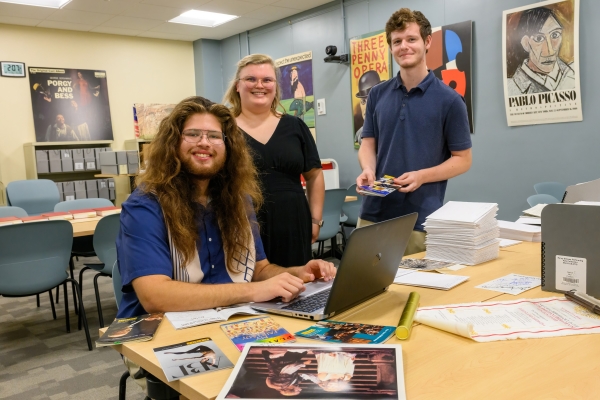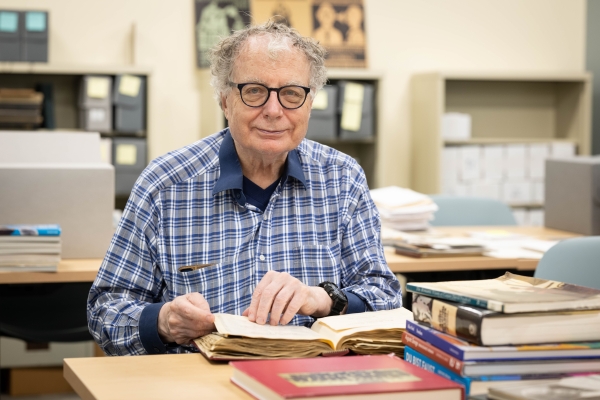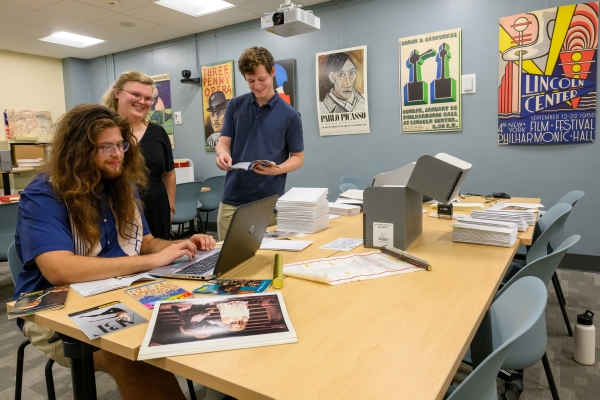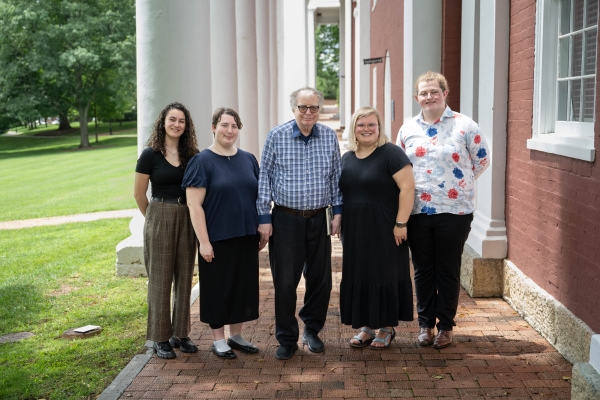An Extraordinary Opportunity Through W&L’s Summer Research Scholars program, Landon Rollins ’26 and John Paul Hammond ’27 are working in Special Collections to process an alumnus’ expansive performing arts collection.
It isn’t every day you stumble across a theater playbill listing a then-unknown Christopher Walken among its cast, but for Washington and Lee University students Landon Rollins ’26 and John Paul Hammond ’27, such a discovery is almost commonplace these days.
Rollins and Hammond are participating in W&L’s Summer Research Scholars (SRS) program, which supports students in collaborative research supervised by W&L faculty and staff, and are spending the summer in the university’s Special Collections and Archives, describing the thousands of materials donated by Henry Strouss ’61.
The collection — which began with Strouss’ first donation in 1988 — includes a wide range of performing arts materials, particularly theater and opera playbills or programs that Strouss has collected over the years or has been gifted by friends who know of his love for the performing arts. The materials encompass a variety of venues, performances and genres, spanning from the late 19th through the 21st century, and many also include autographs from performers.
Led by Mattie Clear, assistant professor and instruction and outreach archivist in the library, Rollins and Hammond are continuing the work to describe and make accessible the collection that was started by last summer’s SRS student, Amelia Fisher ’24. Given the size and scope of the collection, they are focusing on materials from the Lincoln Center in New York City. In describing the individual programs, they note the performance, date and venue, as well as the top five most important individuals, such as the director, choreographer and lead roles; they also note any understudy substitutions or other announcements made at the time of performance. The purpose of including the details in each program is to create an organized and accessible archive that future scholars can use to research historical trends in the performing arts industry, including ones related to inclusivity, repertoire and marketing.
“This is an ideal project for me because you get such an intimate view of the historical trends of music and how these performances are presented to the public.”
~ John Paul Hammond ’27
History’s Hidden Gems
For Rollins, an earth and environmental science major with a minor in studio art, working with the Strouss collection has been an exciting way to expand his arts exposure, and he has enjoyed rediscovering historical performances he’s studied before. “One of my favorite discoveries has been a program from a performance of ‘Cyrano de Bergerac,’ a French opera that I have loved ever since I saw it in high school, and it was so interesting to see how it had been adapted,” Rollins said.
Rollins has also enjoyed recognizing the actors listed across playbills and seeing their trajectory from debut performances to lead roles and was surprised to find a program from the early 1970s with Christopher Walken listed in a minor role. “It’s really interesting to see people getting their start, or to preserve what are maybe the only instances of an actor appearing in a production,” he said.
Hammond, already an avid listener of classical music, appreciates the exposure to the range of music found in the Strouss collection, and is also using his time in the archives to expand the repertoire for his radio show on W&L’s station WLUR, “Saturday Morning with the Classics.”
“This is an ideal project for me because you get such an intimate view of the historical trends of music and how these performances are presented to the public,” said Hammond, who plans to declare a double major in music and history. “I’m gaining a better understanding of how the classical tradition has changed in the United States over the past 50 years. And as I go through the programs, I’ll find a piece of music I haven’t heard and put it on in the background as I work, which gives me a greater appreciation for the materials.”
Hammond also enjoys witnessing the transitional and historical moments through the lens of the Strouss collection, recalling a program with an autograph from the operatic tenor Luciano Pavarotti and a later program from the Metropolitan Opera following Pavarotti’s death in 2007 that features a performance of Giuseppe Verdi’s “Requiem” (a traditional performance held in memoriam of significant figures within the Met).
Learning the Archives
For Clear, who has been working with the Strouss Collection since her arrival to W&L in June 2022, it was important to supplement Rollins and Hammond’s description work with exposure to the larger archival profession. Both students attended the Virginia Caucus meeting of the Mid-Atlantic Regional Archives Conference hosted at W&L in June, which helped them better understand the numerous and interdisciplinary applications of archival work.
W&L’s Special Collections encapsulates this broad interpretation of archival work, with a range of disciplines making use of the collections each semester.
“I have worked at institutions that are much larger than W&L, and I continue to be surprised by the sheer amount of materials that we have, how we’re able to grow the collection and the creative ways we can use the collection in classes,” Clear said. “Special Collections here has always been very user- and access-focused, and we hosted approximately 60 distinctly different classes in Special Collections last academic year, pulling materials from across disciplines and working with students to apply the sources to their coursework.”
Over the summer, Hammond has also grown to appreciate how community-focused the university’s collections are and the role Special Collections and Archives plays in preserving local history about Lexington, Buena Vista and Rockbridge County. “It’s such an admirable mission for a school this size, and I’ll meet people in town who tell me the Special Collections is their favorite part of Leyburn Library, and they spend a good deal of time in the reading room going through the materials that interest them,” he said.
In addition, both Rollins and Hammond are impressed by the sheer volume of the Strouss collection and proud that such a robust collection of performing arts history is housed at W&L where scholars from across the country can access it. Clear pointed out that some venues represented in the collection, like the Lincoln Center and Carnegie Hall, did not establish their own archives at the outset, which means it is likely that many of the programs in the Strouss collection are only accessible here at W&L and not at the institution itself.
The significance of the Strouss collection can also be seen in the types of materials it contains, as a majority are playbills, programs, posters and other items typically made for a single use without intent of preservation, making them valuable markers of a specific moment in time.
“Programs are such ephemeral things because most people don’t keep them or they throw them away as soon as they leave the theater,” Hammond said. “But the fact that we have them and can comb through them and see these very subtle changes over time is really quite an extraordinary opportunity.”
Individuals interested in seeing the Henry Strouss Performing Arts Collection in person may do so by visiting Special Collections and Archives. Their reading room is open to researchers Monday-Friday 10am-4pm during the academic year unless otherwise noted on the library webpage.
If you know any W&L students who would be great profile subjects, tell us about them! Nominate them for a web profile.
A Rich History
Amelia Fisher ’24 began processing the Strouss Collection as an SRS student during the summer of 2023 and found that it perfectly blended her interests in history, theater and education. “This experience speaks to the opportunities you have at W&L, and it was a joy to work on a team to organize something that will benefit student researchers long after I’ve graduated,” Fisher said.
Fisher also had the opportunity to meet with Henry Strouss ’61 and speak with him about his collection, conducting formal interviews as well as having conversations with Strouss and his wife, Jo, about their experiences and passion for the performing arts. “I love stories and storytelling, and our conversations added color to the materials that were already rich with their own histories before landing in the Strouss family’s hands,” Fisher said.
Fisher is currently working as a campus ministry intern at the University of Mary Washington through the InterVarsity Christian Fellowship.
 Landon Rollins ’26 (left) and John Paul Hammond ’27 (right), supervised by Mattie Clear (middle) are processing the expansive performing arts collection donated by Henry Strouss ’61.
Landon Rollins ’26 (left) and John Paul Hammond ’27 (right), supervised by Mattie Clear (middle) are processing the expansive performing arts collection donated by Henry Strouss ’61. Henry Strouss ’61 visited W&L in the summer of 2023 to discuss his collection with the Special Collections and Archive staff and student researchers.
Henry Strouss ’61 visited W&L in the summer of 2023 to discuss his collection with the Special Collections and Archive staff and student researchers. Rollins and Hammond enjoy making discoveries in the Strouss Collection materials, including understudy performances and autographs from famous performers.
Rollins and Hammond enjoy making discoveries in the Strouss Collection materials, including understudy performances and autographs from famous performers. Amelia Fisher ’24 (second from left) with Henry Strouss ’61 (center) July 2023.
Amelia Fisher ’24 (second from left) with Henry Strouss ’61 (center) July 2023.
You must be logged in to post a comment.